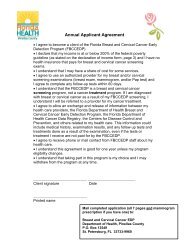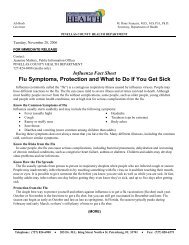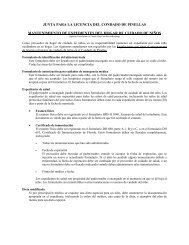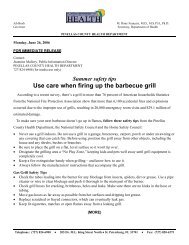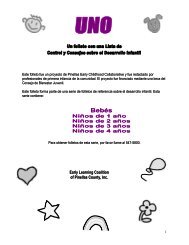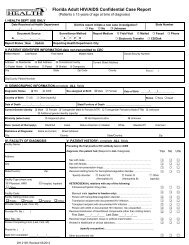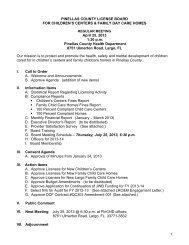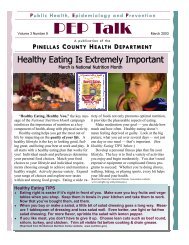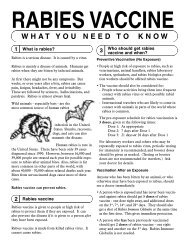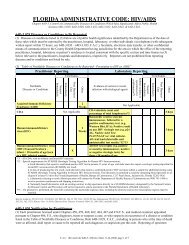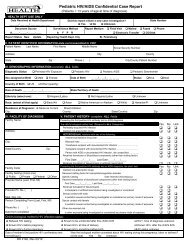Head Lice - Pinellas County Health Department
Head Lice - Pinellas County Health Department
Head Lice - Pinellas County Health Department
You also want an ePaper? Increase the reach of your titles
YUMPU automatically turns print PDFs into web optimized ePapers that Google loves.
Jeb Bush<br />
Governor<br />
M. Rony François, M.D., M.S.P.H., Ph.D.<br />
Secretary, <strong>Department</strong> of <strong>Health</strong><br />
PINELLAS COUNTY HEALTH DEPARTMENT<br />
• Nymph: The nit hatches into a baby louse called a nymph. It looks like an adult head louse, but is smaller.<br />
Nymphs mature into adults about seven days after hatching. To live, the nymph must feed on blood.<br />
• Adult: The adult louse is about the size of a sesame seed, has six legs and is tan to greyish-white. In persons with<br />
dark hair, the adult louse will look darker. Females, which are usually larger than the males, lay eggs. Adult lice<br />
can live up to 30 days on a person's head. To live, adult lice need to feed on blood. If the louse falls off a person, it<br />
dies within two days.<br />
Where are head lice most commonly found?<br />
They are most commonly found on the scalp, behind the ears and near the neckline at the back of the neck. <strong>Head</strong> lice<br />
hold on to hair with hook-like claws found at the end of each of their six legs. <strong>Head</strong> lice are rarely found on the body,<br />
eyelashes or eyebrows.<br />
What are the signs and symptoms of head lice infestation?<br />
• Tickling feeling of something moving in the hair.<br />
• Itching, caused by an allergic reaction to the bites.<br />
• Irritability.<br />
• Sores on the head caused by scratching. These sores can sometimes become infected.<br />
How did my child get head lice?<br />
• Contact with an already infested person is the most common way to get head lice. <strong>Head</strong>-to-head contact is<br />
common during play at school and at home (sports activities, on a playground, slumber parties, at camp, etc.).<br />
• Less commonly, Wearing clothing (hats, scarves, coats, sports uniforms, hair ribbons, etc.) recently worn by an<br />
infested person.<br />
• Using infested combs, brushes or towels.<br />
• Lying on a bed, couch, pillow, carpet or stuffed animal that has recently been in contact with an infested person.<br />
How is head lice infestation diagnosed?<br />
Note: This information is not to be used for self-diagnosis or as a substitute for consultation with a health care<br />
provider. If you have any questions about head lice or think that you or your child may have a parasitic infection,<br />
consult a health care provider.<br />
An infestation is diagnosed by looking closely through the hair and scalp for nits, nymphs or adults. Finding a<br />
nymph or adult may be difficult, because there are usually few of them and they can move quickly from searching<br />
fingers. If crawling lice are not seen, finding nits within a 1/4 inch of the scalp confirms that a person is infested and<br />
should be treated. If you only find nits more than 1/4 inch from the scalp (and don't see a nymph or adult louse), the<br />
infestation is probably an old one and does not need to be treated.<br />
For more information, visit www.cdc.gov or www.headlice.org.<br />
###<br />
The mission of the <strong>Pinellas</strong> <strong>County</strong> <strong>Health</strong> <strong>Department</strong> is to promote, protect and improve the health and safety of our community<br />
through public and private partnerships in an environment that respects diversity. www.<strong>Pinellas</strong><strong>Health</strong>.com<br />
Telephone: (727) 824-6900 • 205 Dr. M.L. King Street North • St. Petersburg, FL 33701 • Fax: (727) 820-4275



